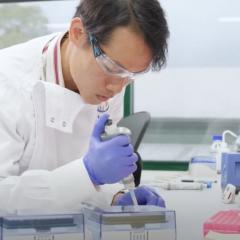QIMR, Griffith University and University of Queensland scientists researching a degenerative brain disease have developed a new way to understand its progression and safely test potential treatments.
The researchers have managed to generate Ataxia-telangiectasia (A-T) patients’ nasal stem cells in the laboratory.
UQ Centre for Clinical Research Professor Martin Lavin, head of QIMR’s Radiation Biology and Oncology Laboratory, said the breakthrough meant scientists could study exactly what was happening in a patient’s brain.
“And we think it means we can make a good contribution to coming up with a drug, to at least slow down the progress of the disease,” Professor Lavin said.
Ataxia-telangiectasia (A-T) is an incurable, degenerative brain disease that leads to severe disabilities, a weakened immune system, and an increased risk of cancer.
Children who have the rare genetic condition are usually wheelchair-bound by their teens and rarely live beyond early adulthood.
Professor Lavin’s team collaborated with Professor Alan Mackay-Sim from the Eskitis Institute for Drug Discovery at Griffith University to generate the stem cells from the olfactory organ in the nose, which are capable of changing into a wide range of specialised cell types.
These multipotent cells are known as olfactory neurosphere-derived (ONS) cells.
The ONS cells help scientists better understand how the condition develops, and allows them to screen a patient for any new drugs which might slow down the progression of the disease.
“These cells from the nasal passage don’t need to manipulated, or have viruses or genes added to them, they simply grow in the lab,” Professor Lavin said.
“And it provides us with very individualised information about a patient.
It means we can screen them for any potential treatments, because we have their exact cells which can be converted into brain or other cell types, and they provide a specific guide to how the disease has taken hold in their brain.”
The QIMR team have also developed a rat model for A-T, which mimics the disease’s effects and are also in the process of making ONS cells from the mutant rats with the Griffith University team.
Future research will involve returning “corrected” ONS back into the rat model’s brain, to see whether the disease progression can be slowed.
“If those experiments work, then there will be the potential to correct the defects in the patients’ stem cells, and transplant them back into a person’s brain as neurons.
It’s just one of the ways we’re trying to tackle a disease which attacks on so many fronts.”
Brisbane has the only Ataxia-telangiectasia clinic in the southern hemisphere, lead by UQCCR researcher Dr Kate Sinclair and a team of clinicians from UQCCR and the Royal Children’s Hospital who also contributed to this study.
The research abstract is available to download in the current issue of Human Molecular Genetics.
Professor Lavin’s research is funded by BrAshAT, an organisation set up by the Roebig family to improve treatment and management of A-T patients and foster research into the condition.
It is also supported by a kind donation from an anonymous donor.
Media contact
Shannah O’Brien (Marketing and Communications Officer (UQCCR), 07 3346 6041 or s.obrien13@uq.edu.au)



